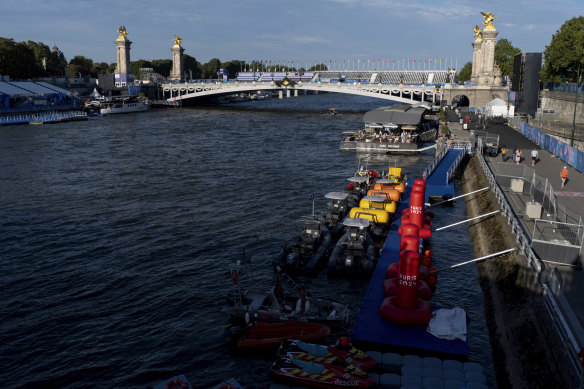
E.Coli is a bacteria commonly found in the lower intestine of warm-blooded organisms. Most E.coli strains are harmless, but some can cause serious illness. Symptoms include abdominal cramps, diarrhoea, fever and vomiting.
Enterococcus faecalis is a common faecal bacteria, also often used as an indicator of water quality at swimming pools and public beaches.

Watercraft and buoys sit along the Seine river as the triathlon event venue on the Pont Alexandre III bridge stands in the background at the 2024 Summer Olympics, Sunday, July 28, 2024, in Paris. (AP Photo/David Goldman)Credit: nna\BGossling
According to European standards, the safe limit for E. coli is 900 colony-forming units (cfu) per 100 millilitres while the threshold for Enterococcus is 330 cfu/100ml.
Which factors influence the water quality?
According to Benjamin Raigneau, director of water quality at the Paris city hall, four main factors have an impact on water pollution.
- Rainfall: More rain more pollution runoff.
- UV index: “The higher the UV index, the faster the bacteria die,” Raigneau said.
- Temperature: The higher the temperature, the faster the bacteria dies. “Whether the temperature of the water is 16 degrees Celsius (60 degrees Fahrenheit), or above 22 Celsius (71 F) like it usually is in the summer, it makes a significant difference,” Raigneau said.
- The flow of the river: The faster the flow the higher the pollution.
What has been done to improve the quality of the water?
Paris has built an underground reservoir designed to hold 46,000 cubic metres of runoff water during a storm, preventing the runoff flooding the city’s antiquated sewage network and allowing untreated waste to flow into the Seine.
Once the water is collected in the Austerlitz basin – a monster, 30-metre deep structure the size of a dozen Olympic swimming pools – it will be directed to a treatment plant before pouring into the Seine.
Loading
How is the decision to allow swimming made?
Every afternoon the day before each familiarisation session (athletes’ swim) and before each competition, a technical committee meets, bringing together all the players involved in the issue of water quality in the Seine: City of Paris, Paris 2024, the International Federation, regional authorities and Meteo France.
At the end of this technical committee meeting, an initial analysis is made of the weather conditions.
At 3:30 a.m. on the day of the competition, a final meeting is held with all those players involved.
Who makes the decision?
The International Federation involved in the sport.
What if the water is not suitable for swimming?
“There are contingency days planned for the summer of 2024 for both sports, which will give us some room for manoeuvre,” Paris 2024 told Reuters.
“Furthermore, the decision-making process will be more refined and precise than ever, as the Eau de Paris laboratory will be analysing the water twice a day.”
If, despite the postponements, the competition cannot take place, the marathon swimming event will take place at the reserve site of Vaires-sur-Marne, where rowing and canoeing events are held.
The triathlon will be turned into a duathlon.
Reuters



























